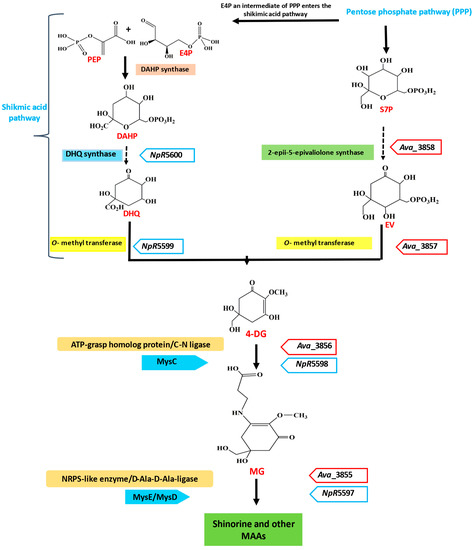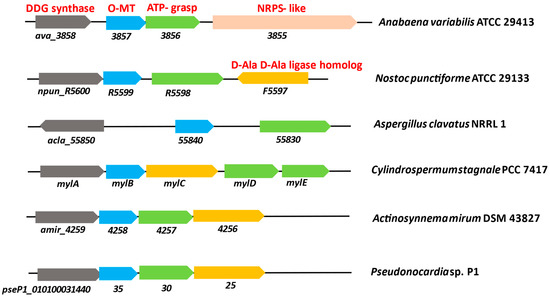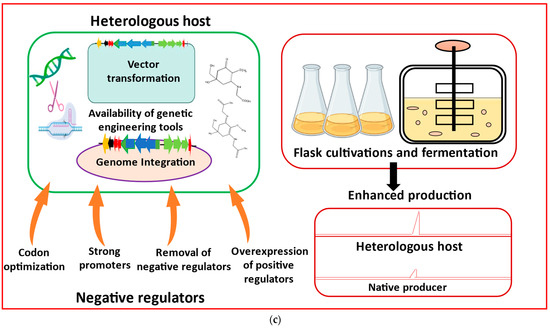You're using an outdated browser. Please upgrade to a modern browser for the best experience.
Please note this is a comparison between Version 1 by Rajeshwar Sinha and Version 2 by Dean Liu.
Ultraviolet (UV) radiation reaching the Earth’s surface is a major societal concern, and therefore, there is a significant consumer demand for cosmetics formulated to mitigate the harmful effects of UV radiation. Synthetic sunscreens being formulated to block UV penetration include inorganic metal oxide particles and organic filters. Lately, organic UV-absorbing compounds are manufactured from non-renewable petrochemicals and, as a result, there is a need to develop a sustainable manufacturing process for efficient, high-level production of a naturally occurring group of UV-absorbing compounds, namely mycosporine-like amino acids (MAAs), for use as a sunscreen additive to skincare products.
- biosynthetic gene clusters
- mycosporine-like amino acids
- sunscreens
1. Introduction
Chemicals, including oxybenzone, ZnO, and TiO2, are frequently used in skincare products to protect against skin damage from UV rays. However, these chemicals have several negative effects on human health and the environment. Several common chemical UV sunscreen filters are absorbed by the skin and enter the bloodstream. The usage of chemical and inorganic sunscreens has increased in recent decades to counteract the harmful effects of UV radiation, but this practice has been linked to a number of skin-related diseases, including skin allergies, rashes, premature aging, dermal cancer, and other skin problems [1]. As a result, there is an increasing need to find bio-based sunscreen chemicals that are efficient, safe, sustainable, and that have the ability to prevent UV-induced damage and boost the effectiveness of natural sunscreens [2]. Mycosporines and mycosporine-like amino acids (MAAs), synthesized by both prokaryotic as well as eukaryotic organisms such as fungi, cyanobacteria, and algae, are natural UV protectants [3]. Mycosporines, which are primarily produced in fungi, consist of the nitrogen substituent of an amino acid or an imino alcohol at the C3 position, forming the cyclohexenone ring, while MAAs have an additional nitrogen substituent conjugated via imine linkage, forming the cyclohexenimine core structure [4]. MAAs are low molecular weight (<400 Da), water-soluble, and colorless UV protectants. They have a high molar extinction coefficient (ε = 28,100–50,000 M−1 cm−1), and their maximum absorption wavelength lies within 309 to 362 nm. These compounds possess a wide array of bioactivities, such as antioxidative, anti-inflammatory, anti-aging, and antitumor activities [1]. Majority of research on cyanobacterial MAAs focuses on specific areas, such as the identification of bioactive compounds, in-depth examination of their molecular mechanisms of action, and the evaluation of their bioactivities via in vitro, in silico, and in vivo analyses.
Lately, the gene-centric approach, or bottom-up approach, has been used to explain the biosynthetic abilities of cyanobacteria by combining in silico studies with functional genomics to link the genomic context, known as biosynthetic gene clusters (BGCs), to target desired metabolites [5]. These days, it is easier to discover the cyanobacterial BGCs of diverse compound families mainly through a number of in silico analysis tools available for cyanobacterial genomic data, including antiSMASH and PRISM [6][7][8][6,7,8]. These resources have made it easier to understand the cyanobacterial MAAs biosynthesis.
Most of the identified cyanobacterial BGCs are silent, making them a greater challenge in MAAs research. Synthetic biology approaches, such as metabolic engineering and strain mutagenesis, have been employed to activate the silent BGCs of other bacterial phyla, for instance, actinomycetes. However, the use of these approaches is less reported for the discovery of cyanobacterial products, mainly because of the slow growth of cyanobacterial strains and because these are genetically less amenable, suggesting an open area to discover and characterize the potential novel compounds from cyanobacteria [9]. The production of the encoded molecule on a large scale for usage at an industrial level has been successfully accomplished through the introduction of targeted metabolite biosynthetic genes into a suitable heterologous host. In order to produce specific metabolite analogues or to maximize the production yield, genetic contents can be redesigned with the help of heterologous expression of the targeted secondary metabolite [10][11][10,11].
2. Application of MAAs (Sunscreen) in Cosmetics
The idea of sunscreen usage has changed from being seen as only a UV-protective compound to provide broad-spectrum defense against photoaging, DNA damage, and dyspigmentation [12]. When selecting a sunscreen, one should take into account the possibility that infrared and visible light contribute to photoaging. UV rays and visible light will be shielded against by using a broad-spectrum tinted sunscreen with SPF of at least 30, which will lessen their impacts on photoaging [12]. For mending skin aging, healing, and avoiding wrinkle development, several microalgal extracts, including those from Spirulina platensis, Chlorella vulgaris, and Dunaliella salina, can be utilized [13][14][13,14]. The extracts might provide creative and potential replacements for current cosmetics, and they encourage the development of new uses for cosmetics.2.1. Photoprotection Prospects of MAAs
MAAs, which are hydrophilic and colorless, are synthesized by marine cyanobacteria [15][16][15,16], microalgae, macroalgae, etc., that function as an antioxidant by reducing ROS-induced DNA damage and as a photoprotectant by protecting cells from UVR [16][17][16,17]. Only a small proportion of these so-called “broad-spectrum sunscreens” are truly efficient at blocking both UV-A and UV-B rays [18]. The strong ability of MAAs to absorb UVR between 309 and 362 nm defines them as a broad-spectrum sunscreen, making it essential to incorporate MAAs as a UV-filter agent in sunscreens [19]. Due to their high photostability, and resistance to heat, pH changes, and various solvents, they can be a very stable cosmetic product [20]. The first sunscreen, called Helioguard 365, was developed by the Swiss Firm Mibelle AG Biotechnology, utilizing a naturally occurring UV-blocking component known as MAA, that contains a certain amount of porphyra-334 and shinorine derived from red algae, Porphyra umbilicalis [21][22][21,22]. The MAAs derived from the algae Dunaliella, Arthrospira, and Chlorella function as sunscreens to mitigate the harm caused by UVR. Odontella aurita, a kind of microalgae, also showed potential free radical scavenging action. Coelastrin A and Coelastrin B, two new MAAs from Coelastrella rubescens, have photoprotective characteristics [23]. The recently discovered MAAs from Klebsormidium, klebsormidin A and klebsormidin B, demonstrated that UVR exposure dramatically induces their production and intracellular enrichment, indicating the role of these molecules as natural UV sunscreens [24]. However, there are still very few MAAs that are commercially available [25]. Additionally, there are two commercial products called Helioguard®365 and Helionori® that both include an extract with an enhanced or specified MAAs content [26]. Porphyra-334 and shinorine both provided concentration-dependent protection when UV-A exposure was evaluated. The recommended dosage for the best protection was 5 μg mL−1 [27]. According to Schmid et al. [26], the formulation they utilized for their study contained 5% of Helioguard®365 (final MAA concentration of 0.005%), the same base with 4% of a synthetic UV-B sunscreen and 1% of a synthetic UV-A sunscreen. It is well-known that Helioguard®365 has anti-aging and photoprotective properties. In a dose-dependent manner, Helioguard®365 concentrations of 0.125% and 0.25% increased cell viability; at 0.25% of Helioguard®365, cell viability was increased by as much as 97.8% [26]. On applying a 2% concentration of Helioguard®365 to the cell lines, the SPF value of the sunscreen increases from 7.2 to 8.2. Sunscreen containing porphyra-334 with shinorine and mycosporine-serinol in the ratio of 4.1:2.9% have the SPF value of 8.37 ± 2.12, whereas for porphyra-334 with shinorine and mycosporine-serinol when applied separately, the SPF value was observed from 4 to 6 [28]. An algal extract having a combination of palythine, asterina-330, shinorine, porphyra-334, and palythinol obtained from H. cornea and G. longissima showed a concentration-dependent increase in the SPF value. At a density of 13.9 mg DW of algae per cm−2, the SPF values of G. longissima and H. cornea, respectively, were found to be 7.5 and 4.8. Both algal extracts increased TNF-α and IL-6 production, while exhibiting no cytotoxicity toward human cells [29]. Shinorine and porphyra-334 extract, which is found in liposomes and is encapsulated in Helioguard®365, reduce the lipid peroxidation of human skin, improve skin firmness and smoothness, and play a role in the prevention of premature aging. Helionori® can prevent sunburn and preserve membrane lipids because it has mycosporine-palythine, porphyra-334, and shinorine, which make it photo- and heat-stable [30]. Biotechnologically, MAAs can be used for a variety of commercial purposes, such as in dietary supplements, medicine, functional organic devices, and others. Therefore, the commercialization of MAAs with multiple uses is an exciting prospective endeavor [31].2.2. Anti-Aging Prospects of MAAs
It might be challenging to characterize skin aging since it is a result of systems involving heredity and environmental variables [32]. Unlike chronological aging, premature skin aging, or photoaging, is brought on by exposure to environmental stress [33]. Clinical manifestations of photoaging include dryness, hyper- and hypo-pigmentation, leathery texture, and wrinkles [33]. As already mentioned, cyanobacteria synthesize molecules that may be used in skin moisturization, UV protection (MAAs and SCY), and shielding against ROS (MAAs, SCY, PBPs, and polyphenols), making them intriguing for use in skin anti-aging treatments [16]. These effects were also mentioned for fibroblasts, which are responsible for the skin’s firmness and elasticity, as well. The extracellular matrix (ECM), which mainly consists of collagen and elastin and provides firmness and elasticity, is produced by fibroblasts within the dermis [34]. In studies employing normal human dermal fibroblasts (nHDFs) exposed to UV-B radiation, it was shown that extracts from Arthrospira platensis increased cell viability and reduced DNA damage by inhibiting thymine dimers and matrix metalloproteinases (MMP) [35]. Mycosporine-glycine, porphyra-334, palythine, and shinorine, the most prevalent MAAs, were examined for their UV-protective properties in recent research using a variety of cell models (human skin fibroblasts and HaCaT keratinocytes) to demonstrate their effectiveness as possible sunscreens [20]. Additionally, a number of anti-aging actions, particularly those that target the elastic fibers of the extracellular matrix (ECM), such as collagen and elastin, as well as their remodeling enzymes, have been identified [36][37][36,37]. Furthermore, there are two commercial products called Helioguard®365 and Helionori® that both include an extract with an enhanced or specified MAAs content [26]. The prevention of skin aging is a result of several mechanisms, including skin hydration, UV protection, stimulation of fibroblast growth, and an increase in antioxidant capacity. Cyanobacteria produce substances that have been shown to interfere with all these processes in the aforementioned areas, making them attractive for cosmetics meant to delay the onset of skin aging.3. Biosynthesis and Genetic Regulation of MAAs
Despite having different molecular structures, mycosporines are composed of a typical cyclohexenone ring structure, which provides them the same spectral characteristics and absorption maxima [38]. Studies have demonstrated that a cyanobacterium or a cyanobacterial ancestor acted as the progenitor of the enzymes for MAAs production [39][40][41][42][43][39,40,41,42,43]. MAAs are synthesized in cyanobacteria using a four-enzyme pathway. It was discovered that different cyanobacterial species exhibit significant genetic variation in the mys gene cluster, which becomes involved in MAAs biosynthesis [44]. The latest studies on the biochemical processes and genetic research have contributed to developing knowledge of the fundamental steps that are involved in the biosynthesis of MAAs. Anabaena variabilis has been used to explain the initial step in the biosynthesis of MAAs. Therefore, it is believed that cyanobacteria were the first producers of MAAs, and the genes for MAA biosynthesis most likely spread to other organisms. The shikimate pathway is suggested as a potential biosynthetic route for MAAs [45]. MAAs are synthesized from phosphoenolpyruvate (PEP) and erythrose 4-phosphate (E4P) (an intermediate in the pentose phosphate pathway). PEP and E4P react to form 3-deoxy-D-arabinoheptulosonate-7-phosphate (DAHP), which is catalyzed by the enzyme DAHP synthase. DAHP is further involved in the formation of 3-dehydoquinate (3-DHQ), which is a six-membered carbon ring-like structure (Figure 1). The 3-DHQ produces 4-deoxygadusol (4-DG), which is subsequently followed by gadusol [42]. Through a separate route, sedoheptulose 7-phosphate (S7P), another intermediate product of the PPP, is converted into 4-DG in the presence of the enzyme dimethyl 4-degadusol synthase (DDGS; MysA) and an O-methyltransferase (O-MT; MysB) [46].
Figure 1. Schematic representation of the biosynthetic pathway of MAAs in cyanobacteria. Synthesis from the shikimic acid pathway intermediate and the pentose phosphate intermediate is shown. Enzymes and genes (in italics) involved in the bioprocess are mentioned on both sides of the arrows. PEP, phosphoenolpyruvate; E4P, erythrose 4-phosphate; DAHP, 3-deoxy-D-arabino-heptulosonate; S7P, sedoheptulose-7-phosphate; 3-DHQ, 3-dehydroquinate; EV, 2-epi-5-epi-valiolone.
Table 1. The enzymes along with their genes that are involved in the biosynthesis of MAAs in different organisms.
| Organism | Genes (Protein ID) | Accession No. | ||||
|---|---|---|---|---|---|---|
| DDG Synthase | O-MT | ATP-Grasp | NRPS-like | D-Ala D-Ala Ligase Homolog | ||
| Anaebena variabilis ATCC29413 | ava_3858 (ABA23463.1) |
ava_3857 (ABA23462.1) |
ava_3856 (ABA23461.1) |
ava_3855 (ABA23460.1) |
- | CP000117.1 |
| Nostoc punctiforme ATCC29133 | npun_R5600 (ACC83905.1) |
npun_R5599 (ACC83904.1) |
npun_R5598 (ACC83903.1) |
- | npun_F5597 (ACC83902.1) |
CP001037.1 |
| Aspergillus nidulans FGSC A4 | an6403.4 (CBF69538.1) |
an6402.4 (CBF69540.1) |
an6402.4 (CBF69540.1) |
- | - | BN001301.1 |
| Actinosynnema mirum DSM 43827 | amir_4259 (ACU38114.1) |
amir_4258 (ACU38113.1) |
amir_4257 (ACU38112.1) |
- | amir_4256 (ACU38111.1) |
CP001630.1 |

Figure 2. Genes involved in the biosynthesis of mycosporines and MAAs in cyanobacteria and other organisms. A. variabilis ATCC 29413 and N. punctiforme ATCC 29133 are known producers of MAAs. Comparison of genomic regions of Anabaena variabilis ATCC 29413 and N. punctiforme ATCC 29133 with Aspergillus clavatus NRRL 1, Cylindrospermum stagnale PCC 7417, Actinosynnema mirum DSM 43827, and Pseudonocardia sp. P1 (modified from Miyamoto et al. [57]).
4. Toolkits for Heterologous Production of MAAs
The production of MAAs from both native and heterologous hosts has been transformed by recent developments in metabolic engineering methodologies and the use of synthetic biology technologies [59]. Cloning and assembly can be the main focus for the heterologous expression of cyanobacterial MAAs, followed by BGC expression, heterologous host selection, and product optimization (Figure 3).

Figure 3. Major metabolic engineering and synthetic biology toolkits essential for heterologous production of mycosporine-like amino acids (MAAs) are listed as: (a) Genome mining using cyanobacterial genomic databases to identify BGCs responsible for MAAs biosynthesis. Domain ‘A’ represents adenylation, and ‘C’, ‘T’, ‘E’, and ‘TE’ represent condensation, thiolation, epimerization, and thioesterase, respectively. Acyl-CoA ligase (AL) and acyl-carrier protein (ACP) are additionally needed to initiate the secondary metabolite biosynthesis. (b) Restriction digestion and ligation, a primary approach of cloning and assembling BGCs, is most commonly utilized for heterologous expression of MAAs. (c) Considerations for heterologous expression and product analysis in heterologous hosts (modified from Sharma et al. [60]).
